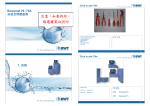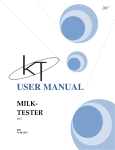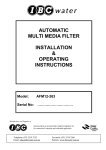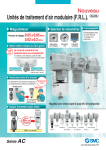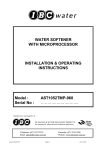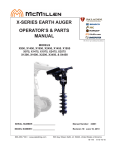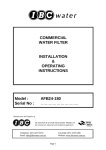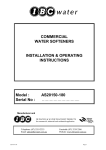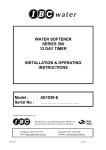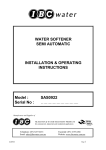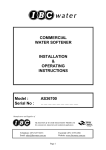Download AFM30-172 - IBC Water
Transcript
COMMERCIAL WATER FILTER INSTALLATION & OPERATING INSTRUCTIONS Model : Serial No : AFM30-172 ……………………….. Manufacturer and Supplier of FILTRATION & WATER TREATMENT PRODUCTS for commercial, industrial and residential application Telephone: (07) 3219 2233 Email: [email protected] Facsimile: (07) 3219 2266 Website: www.ibcwater.com.au Page 1 OPERATING PRINCIPLE General Our AF Series Filters are fully automatic incorporating Backwash, Rinse-Pause, Fast Rinse and Service Cycles. Note: During the purge cycle there is no bypass available for service. If a continuous supply is required a duplex or multiple vessel system is required. Water enters the unit through the multi-port valve and passes through the media, underdrain gravel and the distributor leaving through the multi-port valve. Multi-Media Filters - Sediment Removal Remove filterable turbidity at high flow rates several times the flow rate of conventional filters producing clear filtered water down to 10 micron through the stratified bed without chemical flocculation. No additional pumping is necessary for Backwashing as the Backwash water required is normally only 75% of the service flow rate. Filter capacity is many times that of conventional filtration due to utilisation of the entire stratified bed, resulting in low operating costs. This unit is not designed to remove colloidal matter, a plant capable of coagulation is required in such cases. Operating Parameters Water Temperature Water pH Water Pressure Oil 5ºC - 50ºC 5.5 - 9.0 460 - 690 kPa Free of Hydrocarbons AF SERIES FILTERS Table 2 TYPE MODEL CONTINUOS FLOW RATE L.P.M * PEAK FLOW RATE L.P.M MultMedia AFM30 305 384 Valve 172 BACKWASH FLOW RATE L.P.M VALVE APPROX. WEIGHT KG 172 867 270 Inlet (mm) Outlet (mm) Drain (mm) 50 50 50 Operating Pressure: 460 - 690 kPa Temperature: 5ºC - 50ºC OPERATING PROCEDURES Water Temp: 5ºc - 50ºc Water pH: 5.5 - 9.0 Suspended Solids Max 500 mg/l (Refer factory) Iron: No effect Oil: Free of Hydrocarbons NOTE: Not recommended for Colloidal Sediment removal Electrical: 240V 50Hz 3 watts maximum Warning: A pressure reduction valve should be installed if water pressure at any time is above 690 kpa and if water hammer prevails. Table at left shows recommended MINIMUM plumbing sizes. FAILURE TO OBSERVE WARNING WILL VOID WARRANTY Page 2 INSTALLATION 1. Check the equipment upon arrival for damage or shortages and report same to our Office or Agent before commencing installation. 2. Prior to loading the media locate the unit on a clean, firm, level foundation, preferably concrete, with sufficient space for operation and maintenance. 3. Media loading - see page 4 4. Refit the top adaptor to the tank using silicone grease and install top and bottom pipework to the tank union connections. 5. If the 172-control system is not already assembled to the tank, insert between unions on the tank piping. "top of the Tank" fitting connects to inlet pipe at top of conditioner tank. The valve timer will face upwards and the cover will face forward. 6. a) Use only pipe sizes recommended for this unit. b) Fit pipe unions or flanges to inlet, outlet and drain lines for ease of access for maintenance or cleaning. c) Install inlet and outlet isolating valves and a manual bypass valve. d) Connect pipework and valves MUST be support to prevent loading on the valve and filter. Before connecting pipework, flush or lines, close inlet, outlet and bypass valves. e) The drain line must discharge into open drain or pipe, with a minimum of 100mm diameter and an air gap to conform to sanitary codes and permit observation, not more than 7.6 metres from the unit. f) Power supply is required not more than 1.5 metres from the unit and should be a 3 pin 10A 240V 50Hz G.P.O preferably earth leakage protected. Total power draw is 13 watts maximum. g) Fit external backwash flow controller provided to the filter valve drain port. h) Remove air valve, situated at the top of the pipework. i) SLOWLY fill the tank with water until water flows from the air valve hole - turn water off. j) Replace air valve. k) Connect the tube drain port of the 172 valve located on the right hand side to the open drain. l) Minimum operation pressure 460 kPa (65 p.s.i). Maximum operating pressure 690 kPa (100 p.s.i). If supply pressure is above 690 kPa (100 psi) fit a pressure reducing valve, this must be a non fluctuating supply. WARNING: Failure to use a pressure reducing valve for suppliers over 690 kPa inlet pressure or where water hammer exists will VOID warranty. Page 3 MEDIA INSTALLATION 1. Carefully remove the large adaptor on top of the tank. It is recommended to utilise the optional "C" type spanners. Ensure the tank is empty and clean. 2. CAUTION: 3. Pour in underbed gravel, 200kg of No. 6 gravel. 4. Level out the underground gravel using a broom handle or PVC pipe. 5. Load the media: 6. After loading and levelling the No. 6 gravel under bed, place the media in the tank in the correct order which is D1, D2, 7m sand & D3. 7. Slowly fill the tank up with water. 8. To obtain optimum performance from our unit, exercise particular care in ensuring that each grade of media is levelled evenly over the previous layer. 9. Clean the top of the neck and threads of all traces of media. When pouring underbed gravel in, be careful not to damage the distributor assembly in the bottom of the vessel. Refer Table 1 for media quantities. Page 4 MEDIA PLACEMENT MULTI-MEDIA SEDIMENT FILTER Table 1 Sequence in Tank AFM30 1st (in bottom of tank) 120kg #6 gravel (6 x 20kg) 2nd 88kg D1 (4 x 20kg + 8) 3rd 88kg D2 (4 x 20kg + 8) 4th 200kg 7m sand (10 x 20kg) 5th 132kg D3 (6 x 20kg) Page 5 COMMISSIONING Step 1: Refer to Series 172 Control System section. Step 2: Perform the procedures indicated under "Start Up Procedure" page 10. Note: It is normal for a small amount of media fines to be discharged to drain during the initial backwash. Step 3: Set timer function after determining a regeneration schedule. Note: An initial guide would be to set the frequency to twice per week eg. Tuesday and Saturday and alter this frequency after the filter load pattern has been determined. Step 4: The filter has been factory time set for the various sequences. If it is desired to modify these refer to page 11. Step 5: Check with site supervisor that unit can go on line. If so - slowly open outlet isolating valve fully, check that manual bypass valve is fully closed. This unit is now on line. Step 6: Check for and report any leaks. Page 6 Series 172 Control System Backwash Filter Option Page 7 Design Advantages 1. Construction. Noryl* construction of the Series 172 assures the best mechanical durability and long term resistance to water treatment associated chemicals. 2. Flapper design. Flapper (valve disc) design is the most reliable way to control water in softeners/filter applications because of static sealing and complete lack of problems with dirt in water. 3. Porting. Full 2" (5cm) unobstructed interior porting for high service flow rates and low internal pressure drop. Total valve pressure drop of less than 10 psi (0.7 BAR) at a flow of 100 GPM (6.3 l/sec.). 4. Timer Operation. Fully automatic operation with: (a) 6-or 7-day timer. Operates once each selected day. (b) Impulse initiation. Impulse signal duration must be 3 minutes minimum (45 minutes maximum) at operating voltage. Water meter, external timer, pressure switch, etc., may be used to provide signal. 5. Electrical Signal. Two electrical switches, riding on individual cams, can provide a signal during entire regeneration and/or any desired position of the completed cycle by simply trimming one or both of the cams. This can be done at the time of installation or at a later date. 6. Hydraulic Signals. Positive (pressure equal to service pressure) is available during backwash period, purge period, and during entire regeneration period. Signal exhausts to drain when no "on". 7. Backwash. Backwash period adjustable form 3 to 27 minutes (3 minute increments) with standard speed cam drive, and 1.5 to 13.5 minutes. (1.5 minute increments) with optional high speed cam drive. Porting gives an anticipated 60GPM (3.8 l/sec.) at 50 psi (3.5 BAR). An increase in flow can be achieved by adding an auxiliary valve. Flows up to 80 GPM (5 l/sec.) at 50 psi (3.5 BAR). 8. Purge. Purge period adjustable from 5 to 35 minutes (4 minute increments) with standard speed cam drive, and 2.5 to 17.5 minutes (2 minute increments) with high speed cam drive. Flows up to 54 GPM (3.4 l/sec.) at 100 psi (6.9 BAR). 9. Simplicity. Fewer total parts than and control of comparable function. 10. Valve Operation. Valve discs are sequenced by hydraulic plungers on rolling diaphragms making for a smoother, quieter operation. 11. One Motor. A single synchronous electric motor operates both the program time and the valve controller. Other systems use from two to five electric motors and/or solenoid valves. 12. Durability. The system uses no piston or close tolerance parts in the water stream and no top distributor-operation of valve unaffected by-iron bearing waters. 13. Timer. Series 440 or 450 timers actuate seven three-way valves that in turn pilot the plunger/diaphragm assembly for reach flapper. The load on timer gears and motor is minimised, as timer is for low flow, low force pilot operation only. 14. Appearance. Compact valve design with small timer is visually more compatible to small tank diameters. 15. Two Options Available. Option F1 for single units where raw (unfiltered) water is used for backwash and purge. Option F2 permits use of treated (filtered) water for backwash and purge in multi-unit systems. Operational Advantages 1. No dynamic seals to cause leakage through wear or fatigue. 2. The system can be indexed manually to any one of its regeneration positions. A read out on the camshaft indicates valve position. 3. Each individual valve disc closes with water pressure, plus spring assistance, thus insuring leak-tight closing. 4. The control is of three-cycle design (refer to flow diagrams for details). A separate pilot is provided to give a pressure cycle during regeneration. Allows easy use of service, bypass, and lockout diaphragm valves. 5. Quick disconnect couplings with 2" NPT (BSPT optional) threads are supplied to facilitate assembly and service-saving the expense of 2" unions. 2" PVC socket weld fittings are also available. 6. Simple, easy-to-understand design makes field servicing fast and economical. 7. In normal operation it is impossible for the system to get out of phase or proper sequence. The control always returns to "Service" position after regeneration. 8. Total regeneration time with above adjustments is from 24 to 76 minutes with standard speed cam drive and 12 to 38 minutes with high speed drive. Bonus Advantages 1. 2" control competitively priced with 1-1/2" controls permit the designer to use the same valve for a broad range of equipment. 2. Significant cost savings are realised in shipping and transporting due to use of lightweight materials. 3. The simplicity of the final assembly allows a water conditioner to be shipped prefabricated, but unassembled, and without expensive crating. 4. Built-in auxiliary hydraulic signals permit easy use of large diaphragm valves. Page 8 *Noryl is a Trademark of General Electric Company INSTALLATION General The control is sometimes shipped as a subassembly to avoid damage in transit. The water conditioner should be assembled, piped and wired according to the manufacture's recommendations. The following instructions are provided as a general guide. Plumbing Valve installation (see figure 1) If the control system is not already assembled to the tank, insert between flanges on tank piping. "Top of Tank" fitting connects to inlet pipe at top of conditioner tank. The valve timer will face up-ward and the cover will face forward. Figure 1 Inlet and Outlet piping (see figure 2) All inlet and outlet piping should be anchored or supported adequately to avoid placing stress on the control system. Follow good plumbing practises and conform to any local codes. Figure 2 illustrates a suggested hookup involving the use of separate inlet, outlet and by-pass valves. This arrangement provides shut-offs and emergency bypass of unconditioned water in the event the unit must be serviced. The flanged fittings provided will be one of the following: a. 2" NPT brass b. 2" BSPT brass c. 2" PVC for solvent welding d. 63mm PVC for solvent welding Figure 2 Be sure to apply adequate silicon grease lubrication on all "O" rings. Hand tighten cast metal nuts to valve being careful not to cross thread. Then wrench tighten a maximum of 1/4 turn. Drain line piping (see figure 1 and 3) The valve drain fitting located on the back of the valve and marked DRAIN, is 1-1/2" NPT or optionally BSPT. The valve does not provide any internal means of backwash flow control. Backwash flow rate is predetermined by the tank size. A properly sized flow controller (Figure 3) must be installed in the drain line to prevent media loss. Electrical A fused, 120V 60Hz (240V 50Hz optional power supply is required (refer to General Specifications, page 10). The outlet used should not be switched controlled. Low wattage requirements (less than 3 watts) allow the use of a three wire flexible cord. However, local electrical codes must be met. The holes in top plate are adaptable to conduit, BX, Romex, etc. Any interruptions in electrical power will cause a change in the desired time of regeneration. When occurring during regeneration, the valve will stay in Figure 3 Page 9 a particular position until power is restored. Timer must be reset after a power interruption. START-UP PROCEDURE Includes procedures to pressurise filter tank With all piping and installation completed, and with mineral in the tank, proceed as follows: 1. Disconnect electrical power to timer. 2. Remove valve cover to expose timer and mechanism 3. Push in on RED KNOB on timer, turn counterclockwise until arrow on the camshaft/timer support points to the BACKWASH position indicated on #1 cam (see Figure 4). Figure 5 Set Timer Figure 4 4. Slowly open manual inlet supply valve. DO NOT open fully. Water will enter from the bottom of filter tank as air is expelled from the top to the drain. Full flow of water could cause loss of media. Continue to fill slowly until air is expelled and only water flows to drain. 5. When ONLY water flows to drain, open inlet valve fully and backwash until water looks clean when caught in a container. 6. Push in RED KNOB and index pilot valve to PURGE. Allow water to flow to drain until clear (see Figure 5). Determine a regeneration schedule for the filter and adjust the automatic timer (see Figure 6) as follows: 1. Put all SKIPPER PINS up (away from control). 2. Rotate SKIPPER WHEEL until DAY ARROW points to day of week. 3. Depress SKIPPER PIN(S) for day(S) backwash is required. 4. Pull timer knob out (away from timer face) and rotate until BLACK ARROW on tripper arm points to correct time of day on Face Plate. 5. Timer will automatically initiate backwash on preset days at 2:30 A.M. To alter time, simply reset TIMER KNOB to an earlier or later time which will change the time of backwash by the same number of hours. (Time indicated at BLACK ARROW will no longer be correct). Page 10 Figure 6 2. Push the RED KNOB and turn counterclockwise past START to BACKWASH. Leave in position for desired time. 3. Push in RED KNOB and repeat for all desired cycles. Set BACKWASH timing (Figure 7) Make sure time is in the SERVICE position. Loosen the screw (A) on the white gear (B) and rotate the grey gear (C) with the numbered decal until desired time (3, 6, 9, 12, 15, 27 minutes) aligns with pointer on box (D). Tighten the screw on the white gear. Set PURGE timing (Figure 8) Make sure timer is in the SERVICE position. Loosen the screw (E) on the grey gear (F) with the pointer until the pointer aligns with the desired time (5-35 minutes). Tighten the screw. Figure 7 Figure 8 Three pressure taps are available on the Pilot Valve for use in actuating external diaphragm valves. Pressure TAP No. 2 will give a pressure signal during the PURGE cycle; pressure TAP No 3 will give a pressure signal during the BACHWASH cycle; and pressure TAP No 7 will give a pressure signal throughout the entire REGENERATION cycle. Before attaching a tube to any pressure tap, drill out the barrier in the tap using a 1/8" drill. Insert the drill into the opening of the tap and drill the hole in the barrier being careful not to drill through the backwall of the tap. MANUAL OPERATION A. Start-Up or inspection regeneration. 1. Disconnect electrical power. B. Manual initiation of regeneration. 1. Reconnect electrical power. Page 11 2. Push in RED KNOB and turn counterclockwise to the START position. Release. Unit will then go through a complete regeneration as programmed. Flow Diagrams PUSH/PULL ROD 6 OUTLET VALVE DISC 5 BY-PASS 4 DRAIN 3 BACKWASH VALVE CLOSED VALVE OPEN 1 INLET Page 12 3 BACKWASH 2 BRINE (NOT USED FOR FILTER) GENERAL SPECIFICATIONS Hydrostatic test pressure ……………………………………………………………………………………………. 250 psi (17.2 bar) Working pressure ……………………………………………………………………………………….. 20 - 100 psi (1.38 - 6.89 bar) Standard electrical rating ……………………………………………………………………………………………………. 120V/60Hz Optional standard electrical rating (Timers) ………………………………..……… 24V/50Hz, 120V/50Hz, 24V/60Hz, 24V/50Hz Electrical cord (when furnished …………………….………………………………………………….. 6" (150 cm), 3 wire with plug Electrical Connection ………………………………………………………… 1/2" (1.3 cm) conduit opening. Terminal strip inside Standard plumbing connection …………………..……………… 2 in NPT inlet, outlet top and bottom of tank; 1-1/2" NPT drain Union type fittings for inlet, outlet Top and bottom tank ……………………………………...… 2" brass pipe with o-ring seal to valve. Available in standard (NPT) or optional (BSPT) threads. Also available in PVC Rubber parts ………………………………………………………………………………………... Compound for cold water service Control body ……………………………………………………………………………………... Fibreglass reinforced thermoplastic Page 13 BACKWASH FLOW RATE Figure 9 contains a curve indicating the backwash flow rate obtained with the 172 valve at inlet pressure from 20 to 75 lbs/in² (1.4 - 5.1 bar). As is shown, this rate is a function of inlet pressure because of the fixed orifices within the 172 valve. A flow control valve must be placed in the drain line from the 172 valve to maintain the backwash flow at the desired rate. Also shown on Figure 9 is a curve indicating the unit backwash rate versus tank size to maintain a unit backwash rate of 10 gallons/minute/square foot (40.7 ml/min/cm²) of resin bed cross section. To determine if the backwash flow rate is adequate for the selected tank size, Figure 9 may be used as follows: 1. Draw a vertical line from the point on the abscissa (horizontal coordinate) labelled "TANK DIAMETER" for the size tank selected up to the intersection of the "UNIT BACKWASH RATE" curve. 2. From this intersection draw a horizontal line to the ordinate (vertical coordinate) labelled "BACKWASH FLOW RATE" and graduated in gal/min. 3. If the horizontal line intersect the curve for the "BACKWASH FLOW RATE" there will be inlet pressures at which the backwash flow rate will be insufficient. If such an intersection occurs, draw a vertical line from that intersection to the abscissa labelled "INLET PRESSURE" and graduated in lbs/in² (bar). If the design inlet pressure is less than the value indicated on the abscissa, an auxiliary backwash valve will be required. If the inlet pressure is more than the indicated value, the 172 flow rate will be adequate and an auxiliary valve will not be required. There is a further limit to the back wash flow rate due to the flow path from the 172 inlet through the valve to the tank bottom connection port. If an auxiliary backwash valve is to be used, the designer should check that this limitation does not occur. This can be done as follows using Figure 9. 4. Observe that above the curve labelled "BACKWASH FLOW RATE" is another curve labelled "MAXIMUM BACKWASH FLOW RATE AUXILIARY VALVE". If the horizontal line ie., required flow rate, previously determined in paragraph 2 does not intersect this curve, no limitation exists. 5. If the horizontal line does intersect this curve, draw a vertical line from the intersection to the abscissa labelled "INLET PRESSURE". If the design inlet pressure to the unit is above the value indicated on the abscissa, there will be no limitation. 6. If the inlet pressure is less than the value indicated on the abscissa, the backwash flow will be less than required. Sample Problem Lines shown on Figure 9 illustrate this problem: Step 1. Assume tank diameter was 36 inches. Draw vertical line from 36 inches on abscissa labelled "TANK DIAMETER". Step 2. From the intersection of vertical line and "UNIT BACKWASH RATE" curve, draw a horizontal line. Where this line intersects the ordinate, the value of the required backwash flow rate is indicated as 70.6 gal/min (15.9 m³/hr). Step 3. The horizontal line intersected the "BACKWASH FLOW RATE", therefore, draw a second vertical line from the intersection of the abscissa labelled "INLRT PRESSURE". The abscissa value is 67 lbs/in² (bar). If the inlet pressure of the unit is more than this, the backwash flow through the 172 valve will be sufficient. If the inlet pressure is to be less than 67 an auxiliary backwash valve is required. Step 4. Observe that the horizontal line at 70.6 gal/min (15.9 m³/hr) also intersects the curve labelled "MAXIMUM BACKWASH FLOW RATE WITH AUXILIARY VALVE" at 41 lbs/in² (2.8 bar). This becomes the low limit for the inlet pressure is an auxiliary backwash valve is used. The unit backwash rate curve used in Figure 9 was for the rate of 10 gal/min/ft² (40.7 ml/min/cm²). If the designer prefers to use different rates, additional curves may be plotted. Page 14 Page 15 REPLACEMENT PARTS Page 16 VALVE ASSEMBLY PARTS LIST Item 1H-1 1H-2 2H-1 2H-2 3H-1 3H-2 4H-1 Description 4H-2 5H 6H-1 6H-2 6H-2 6H-4 7H 8H-1 8H-2 9H-1 9H-2 10H 11H-1 11H-2 Valve Body NPT Valve Body BSPT Adapter - 2" PVC Adapter - 63 mm PVC Adapter - 2" NPT brass Adapter - 2" BSPT Brass Nut - for 2" NPT, 2" BSPT & 2" PVC Adapter Nut - for 63mm PVC Adapter O-ring Valve Disc #1 & #6 Valve Disc #2 Valve Disc #3 & #4 Valve Disc #5 Screw Cap - Large Cap - Small Spring - Large Spring - Small Push/Pull Rod Piston - Large Piston - Small 12H-1 12H-2 13H-1 13H-2 14H 15H 16H 17H 18H 20H 22H No. Required 1 1 4 4 4 4 Item 23H 24H 25H 4 4 4 2 1 3 1 26 3 4 3 4 7 3 4 26H 27H 29H 30H 31H 33H 34H 35H 36H 37H 38H 39H 40H 41H 43H 44H 45H 46H Diaphragm - Large 3 47H Diaphragm - Small Plate - Large Plate - Small Washer Screw Screw U-Nut O-ring O-ring O-ring 4 3 4 7 7 2 2 1 1 1 47H-1 48H 49H 50H 51H 52H 53H 54H 55H 888D Page 17 Description Injector Cap Screw - Timer Timer - Specific Voltage: Frequency; 6 or 7-day Retaining Ring Timer Mounting Bracket Screw - Timing Gear Screw - Pilot Valve Pilot Valve Body Connection Screw - Small Cap, Top Valve Disc - Pilot Gear - Timing Spring Locking Arm Support - Camshaft & Timer Screw Camshaft Assembly Camshaft Support Rocker Arm Shaft Assembly Spring - Inlet Spring - Drain Cover Timing Gear Assembly F1 & F2 option Timing Gear F1 & F2 option Camshaft Assembly F1 Option Camshaft Assembly F2 Option Cap, Brine Line Injector Blank Nut - Tube Tube Tube Elbow - Tube Filter - Pilot Valve No. Required 1 3 1 1 1 2 5 1 4 7 1 1 1 1 3 1 1 1 1 7 1 1 1 1 1 1 1 1 1 1

















